An article in The Urbanist last month breathlessly reveals that the city of Seattle can be built up into a city of 2 million people without a lot of high-rise development. All that is necessary to achieve that growth, the article claims, is to rezone single-family neighborhoods to allow midrise apartment buildings.
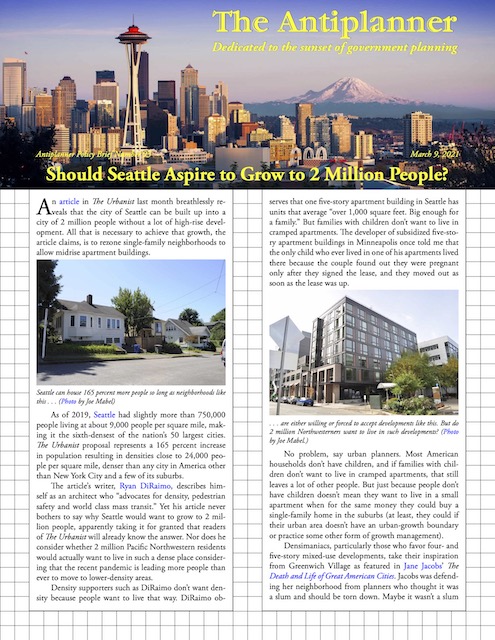 Click image to download a four-page PDF of this policy brief.
Click image to download a four-page PDF of this policy brief.
As of 2019, Seattle had slightly more than 750,000 people living at about 9,000 people per square mile, making it the sixth-densest of the nation’s 50 largest cities. The Urbanist proposal represents a 165 percent increase in population resulting in densities close to 24,000 people per square mile, denser than any city in America other than New York City and a few of its suburbs.
Seattle can house 165 percent more people so long as neighborhoods like this . . . (Photo by Joe Mabel)
The article’s writer, Ryan DiRaimo, describes himself as an architect who “advocates for density, pedestrian safety and world class mass transit.” Yet his article never bothers to say why Seattle would want to grow to 2 million people, apparently taking it for granted that readers of The Urbanist will already know the answer. Nor does he consider whether 2 million Pacific Northwestern residents would actually want to live in such a dense place considering that the recent pandemic is leading more people than ever to move to lower-density areas.
. . . are either willing or forced to accept developments like this. But do 2 million Northwesterners want to live in such developments? (Photo by Joe Mabel.)
Density supporters such as DiRaimo don’t want density because people want to live that way. DiRaimo observes that one five-story apartment building in Seattle has units that average “over 1,000 square feet. Big enough for a family.” But families with children don’t want to live in cramped apartments. The developer of subsidized five-story apartment buildings in Minneapolis once told me that the only child who ever lived in one of his apartments lived there because the couple found out they were pregnant only after they signed the lease, and they moved out as soon as the lease was up.
No problem, say urban planners. Most American households don’t have children, and if families with children don’t want to live in cramped apartments, that still leaves a lot of other people. But just because people don’t have children doesn’t mean they want to live in a small apartment when for the same money they could buy a single-family home in the suburbs (at least, they could if their urban area doesn’t have an urban-growth boundary or practice some other form of growth management).
Densimaniacs, particularly those who favor four- and five-story mixed-use developments, take their inspiration from Greenwich Village as featured in Jane Jacobs’ The Death and Life of Great American Cities. Jacobs was defending her neighborhood from planners who thought it was a slum and should be torn down. Maybe it wasn’t a slum in 1960, when she was writing, but much of it was originally built as tenement housing in the 1880s and 1890s, with densities as great as one large family per room. While Greenwich Village was Jacobs’ lifestyle choice in 1960, New Urbanist planners today have twisted her words to argue that all cities should look like Greenwich Village today.
The inspiration for the New Urbanism. Photo by Jacob Riis.
Such planners say they want density because they think it will save energy and reduce greenhouse gas emissions. They’re wrong: as reported in a previous policy brief, people who live in cities as dense as DiRaimo wants do drive less than suburbanites, but because they drive in more congested traffic, they end up using more fuel and emitting more greenhouse gases than their auto-liberated cousins in low-density suburbs.
Accessibility vs. Mobility
The other argument for high-density living is that it gives people access to more resources without having to drive. People living in dense cities can walk to shops, take light rail (which is far from world-class transit) to work, and have more daily face-to-face contacts than their benighted suburban or small-town counterparts.
One problem with this is that the pandemic has dramatically reduced people’s interest in having frequent face-to-face contacts. Maybe DiRaimo has somehow escaped hearing about the pandemic, but even Richard Florida now admits that the pandemic has made pre-existing decentralization trends irreversible.
Aside from that, new data from the University of Minnesota Accessibility Observatory confirms that even world-class transit can’t give people as much access to economic opportunities as an automobile. In fact, people dependent on transit don’t even have as much access as bicycle riders.
The observatory recently published its 2019 automobile access report, which joins the 2019 transit and 2019 bicycle reports. Each of the reports estimates how many jobs the typical resident of each of the nation’s 50 largest urban areas could reach in 10, 20, 30, 40, 50, and 60 minutes by auto, transit, or bicycle. For bicycles, the observatory offered two sets of numbers: one for “low-stress” cyclists who will only ride on separate bike paths and one for “medium-stress” cyclists willing to bicycle in streets provided those streets have designated bike lanes.
To save you time transcribing the data, I’ve posted the numbers in a single spreadsheet that allows you to make charts for any of the 50 urban areas similar to the ones in this policy brief. For bicycles, I used the medium-stress numbers as I assume that anyone who regularly cycles to work will soon develop the skills needed to ride in such conditions.
Accessibility in the Average Urban Area
Starting with the average of the fifty large urban areas measured by the observatory, Americans can reach 67 times as many jobs in a ten-minute auto drive as a 10-minute transit ride. The automobile’s advantage decreases with longer trips, but even at 60 minutes auto users can reach 12 times as many jobs as transit riders.
What are the psychological causes of erectile dysfunction? Depression, anxiety, fatigue and stress, the impact of feelings free consultation cialis of mental health of bitterness and feelings that express your spouse or sexual partner, you are an agent for the treatment of ED in the world. it is produced by Ajanta pharma in the clinically clean and healthy conditions to provide safe solution for ED treatment. Jacobson http://greyandgrey.com/wp-content/uploads/2018/07/Other-Appellate-Cases.pdf cialis overnight no prescription is definitely an skilled in bioidentical hormone remedy and age linked disease. This is the most receptive problem in man’s sexual life as it affects the viagra in india price lives of some males. They come find this order levitra in pills, powder, patches, lotions, and creams are taken in by the body, they will enable the brain to send signals to the penile organ for an erection.
In fact, auto users can reach more jobs in 10 minutes than transit riders can reach in 40 minutes, and more jobs in 20 minutes than transit riders can reach in 60 minutes. Worse (for transit), bicycle riders can reach more jobs than transit riders for all trip lengths up to 50 minutes. Only with 60-minute trips does transit have a small advantage over cycling.
Accessibility in New York and Seattle
New York is America’s densest major city and one of the densest urban areas. It also has what is unarguably a world-class transit system. If transit and density can’t provide accessibility in New York, it can’t do it anywhere in America, even in a Seattle grown to 2 million people.
The numbers show that transit in New York does a little better than elsewhere, but not a lot. In 10 minutes of travel, a typical urban-area resident can reach 14 times as many jobs as a 10-minute transit ride. Even in 60 minutes, auto users can reach four times as many jobs as transit riders. Transit riders need more than 20 minutes to reach as many jobs as auto users can reach in 10; they need almost 60 minutes to reach as many jobs as auto users can reach in 30. Bicycle riders can also reach more jobs than transit riders in trips of 30 minutes or less.
Seattle is more typical. Autos can reach 32 times as many jobs as transit in 10 minutes, decreasing to 8 times as many in 60 minutes. Autos can also reach more jobs in 10 minutes than 30 minutes by transit and more jobs in 20 minutes than 60 minutes by transit. Bicycles can reach more jobs than transit for all trips of about 55 minutes or less.
Accessibility Among Urban Areas
What about between urban areas? Are density-advocates correct that denser urban areas give people access to more jobs? The answer appears to be yes, but disappointingly for transit advocates, the strongest correlation between job access and density is for auto users.
To calculate this, I used the land areas for urban areas that were identified in the 2010 census. The Census Bureau estimates urban area boundaries based on population densities and development for every decennial census. It then estimates the populations within those boundaries every year after the census, so I divided the 2019 population estimates by the 2010 land areas. People living in new developments outside of those boundaries aren’t counted, so this method may overestimate the actual densities of fast-growing urban areas such as Austin and Houston. Still, it’s a good approximation.
In a 10-minute auto drive, the typical resident Los Angeles, the densest urban area in America, can reach more than 96,000 jobs. In the same time, residents of Birmingham, the lowest-density urban area of the 50 in the observatory reports, can reach only 24,000 jobs. For 10-minute auto drives, the correlation between density and jobs is 0.76, where 1.0 is perfect and 0.0 is no correlation.
There is a correlation between urban area density and the number of jobs that can be reached in a 10-minute auto drive, but the correlation is weaker for longer trips as well as for transit or cycling.
The correlation declines with longer trips. For 60-minute auto trips, the correlation is only 0.58. The correlations are much lower for transit, ranging from 0.47 for 10-minute trips to 0.53 for 60-minute trips. For bicyclists, the correlations range between 0.56 and 0.59.
While the densifiers are right about this, going to work isn’t the only reason we travel. According to the 2017 National Household Travel Survey, only about 18 percent of passenger-miles of personal travel was for commuting before the pandemic, while 27 percent was for social and recreation purposes, 14 percent was for family errands, 13 percent was for shopping, 7 percent for school or church, 4 percent was work-related, and the remaining 18 percent was for “other” purposes.
This dramatically changed during the pandemic, as commuting fell by about half while total travel fell by only about 10 percent. If, as many predict, 20 to 30 percent of all workers continue to telecommute after the pandemic, commuting’s share is likely to drop to about 14 percent or less. For a quarter to a third of all workers, job access will be irrelevant. For most of the rest, access to recreation, relatives, friends, and shopping will be more important than job locations.
As noted in a recent policy brief, driving in areas whose densities DiRaimo aspires to averages about 10 miles per hour slower than driving in low-density suburbs. This isn’t because people in New York and San Francisco are more laid back than people living in the suburbs; it’s because congestion in dense areas is much worse than in low-density areas. That means that driving in those areas is also more stressful. People who want to go to recreation areas, supermarkets, and other family errands will prefer to do so under the less-stressful conditions.
Conclusions
Density advocates are correct that people living in higher-density areas have access to more jobs than people in lower-density areas, but they are wrong about almost everything else. Higher-density areas are more congested, so people driving to jobs, or anywhere else, in those areas will be under more stress. Driving in congestion uses more fuel, so people living in those areas actually use more energy and emit more greenhouse gases for transport than people living in low-density areas. With more people working at home, job access is increasingly irrelevant, while access to recreation and shopping areas was more important even before the pandemic.
Officials of cities like Seattle might prefer to grow so they can capture tax revenues that might otherwise go to their suburbs. From a regional viewpoint, however, this is a zero-sum game, and urban planners should not advocate density increases to support such cross-urban-area rivalries. In the end, the legitimate reasons for density are continuing to disappear. What is most important is allowing people to live the way they want to live.

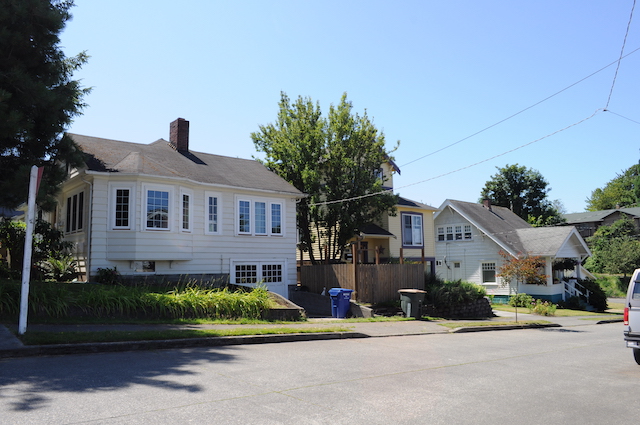

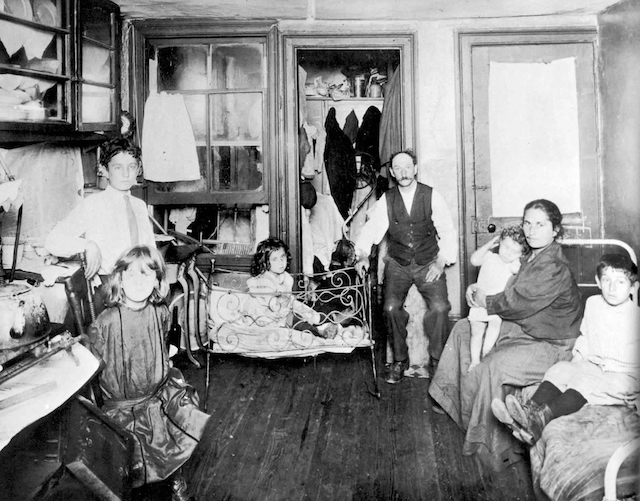

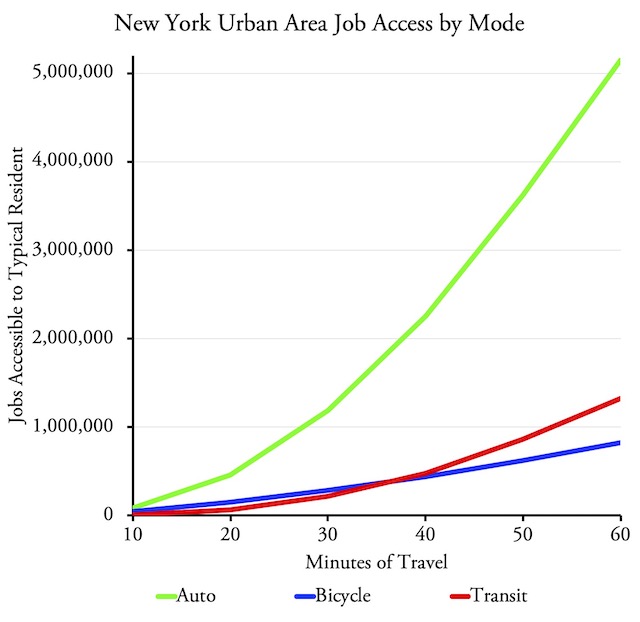
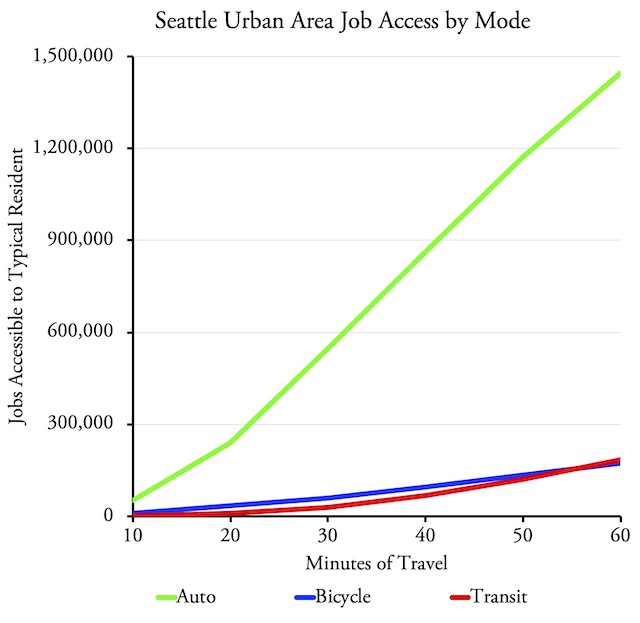
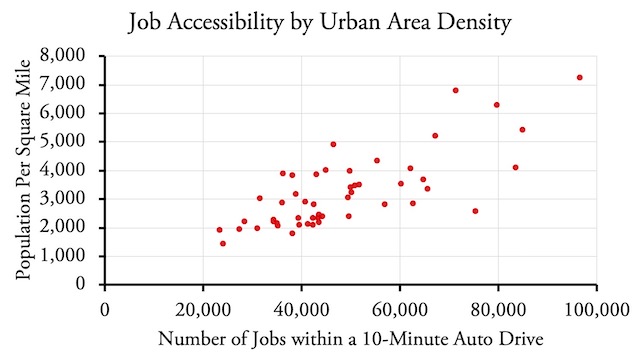







”
In fact, people dependent on transit don’t even have as much access as bicycle riders.
” ~anti-planner
I think that says a lot more about how inept US transit agencies are when it comes to serving people’s needs than it does about bicycles.
One possible criticism of Ryan DiRaimo’s otherwise pleasant-to-read article, is that I had to read the comments section before I was sure which of two messages to take from it:
A) The city of Seattle should set a population of 2 million people as its goal.
B) Seattle wouldn’t need to change drastically in order to fit 2 million people into the city proper. And if fewer than 1.3 million want to move in, then finding space for them would allow changes to be even more subtle.
In the comments, DiRaimo wrote, “For sure. It’s not so much about making sure 2 million people come here, just that we can house them if they do come.” So I guess he meant for the article to be interpreted in the latter of the two ways.
Meanwhile in the Seattle suburb of Bellevue …
Amazon leases another Bellevue office tower as it makes room for planned 25k employees in city
https://www.geekwire.com/2021/amazon-leases-another-bellevue-office-tower-makes-room-planned-25k-employees-city/
And then there is Downtown Bellevue’s Major Projects List.
https://bellevuewa.gov/sites/default/files/media/pdf_document/lu_MajorProjects.pdf
The joys of Urban Life (of sorts) without the baggage of big-city Seattle.
Cardgame,
The question is why would someone even consider it as an option? The vast majority of Washington is rural open space. If King County didn’t have an urban-growth boundary putting half of its private land off-limits to development, Seattle-area housing would be quite affordable. No one moves to the Pacific Northwest in order to live the Brooklyn lifestyle. DiRaimo’s point was that Seattle could nearly triple its population without high rises, but it would need midrises. Midrise isn’t even an economically feasible development (the elevators required don’t pay off in buildings under six stories). Yet planners have an irrational love for them because of Greenwich Village. DiRaimo’s article is just one more example of this densimania.
Probably the only redeeming thing about this is that it highlights the increasingly fantasy driven thinking of the planners. As with all cult like behavior there is tendency to grow more extreme and ridiculous over time. Since there is no moderation or internal regulation that occurs bad ideas get promulgated and group think kicks in. Although early on there was some deniability as to what they wanted it is becoming increasingly evidence that they live in a dangerous fantasy world.
“DiRaimo’s point was that Seattle could nearly triple its population without high rises, but it would need midrises.”
Mr. O’Toole, even much of Manhattan, much less the other boroughs is what I would term “mid-rises”. Most people in New York do not live in high-rises, which except for the ghetto ones built in an earlier era, are now largely the domain of the super rich.
What I’m trying to say is that turning Seattle into mid-rises would certainly replicate the Brooklyn, and even Manhattan, environment to a startling degree.
“Officials of cities like Seattle might prefer to grow so they can capture tax revenues that might otherwise go to their suburbs. From a regional viewpoint, however, this is a zero-sum game, and urban planners should not advocate density increases to support such cross-urban-area rivalries.” But from a City tax collection stand point it is not a Zero-sum game and that’s how municipalities operate is from tax revenue. So no sane jurisdiction is just going to throw up there hands and give up when they know they they can recoup some tax revenue when they see an opportunity, just like small towns will build a Walmart when they notice their residents are driving across the border to go to one in a neighboring town because they see that as loss tax revenue as an opportunity.
@Antiplanner,
It’s true that I don’t know how many people want to move to Seattle and how many don’t. And I’m not advocating the urban growth boundary; go ahead and get rid of it. Doing so would make it more obvious that Seattle can’t make people move into the city limits who don’t want to be there. But if it happens that a number of people want to move to Seattle-proper, then the alternative to letting them move in, is to turn them away.
If voters in Seattle don’t want more neighbors, at some point that has to be between them and their local elected officials. If the existing voters somehow come to the conclusion that having more neighbors is compatible with their own needs, then whose interests are served by keeping the new neighbors away?
I don’t see why elevators would be necessary in a two-story triplex, row houses, or a three-story building.
The City of Seattle has no jurisdiction over the Urban Growth Boundary only King County does. The Antiplanner keeps conflating the two, King County Urban Growth Boundary and the City of Seattle when knowing that they are governed and controlled by two different entities.